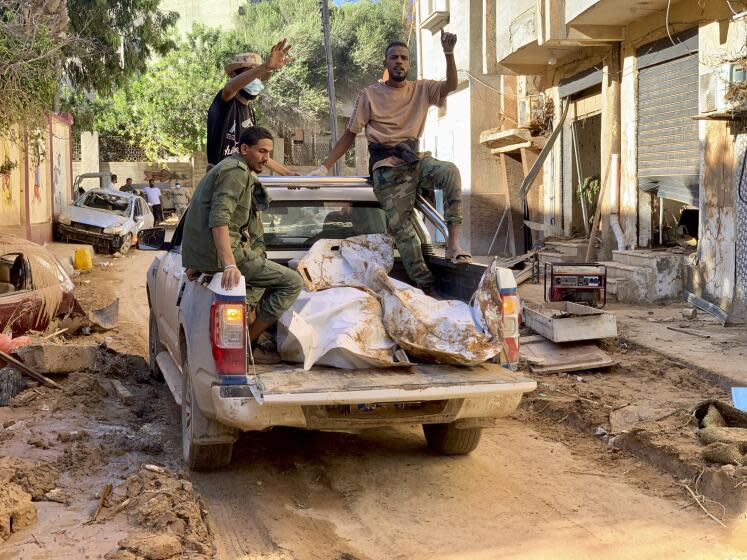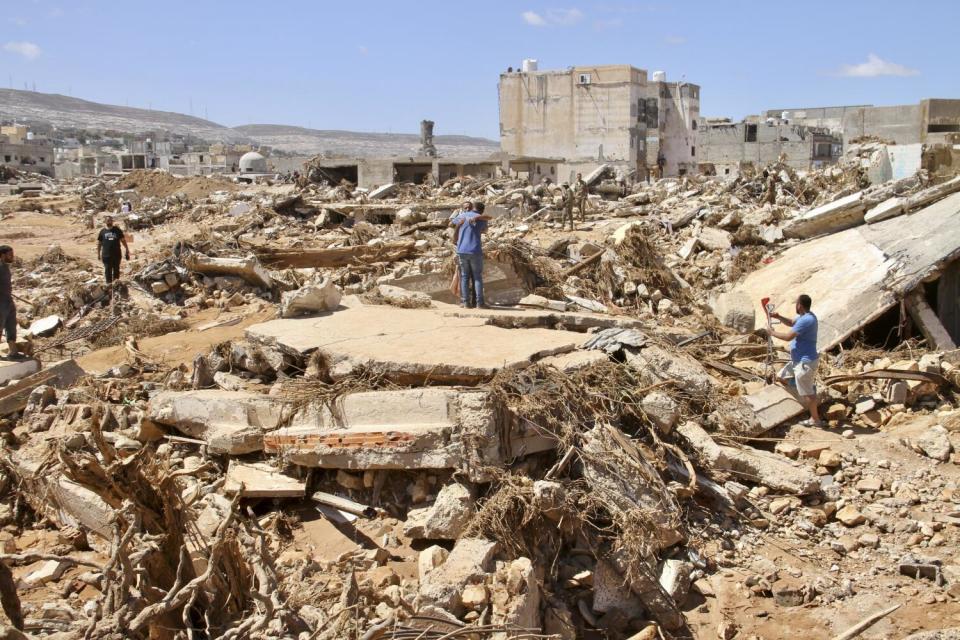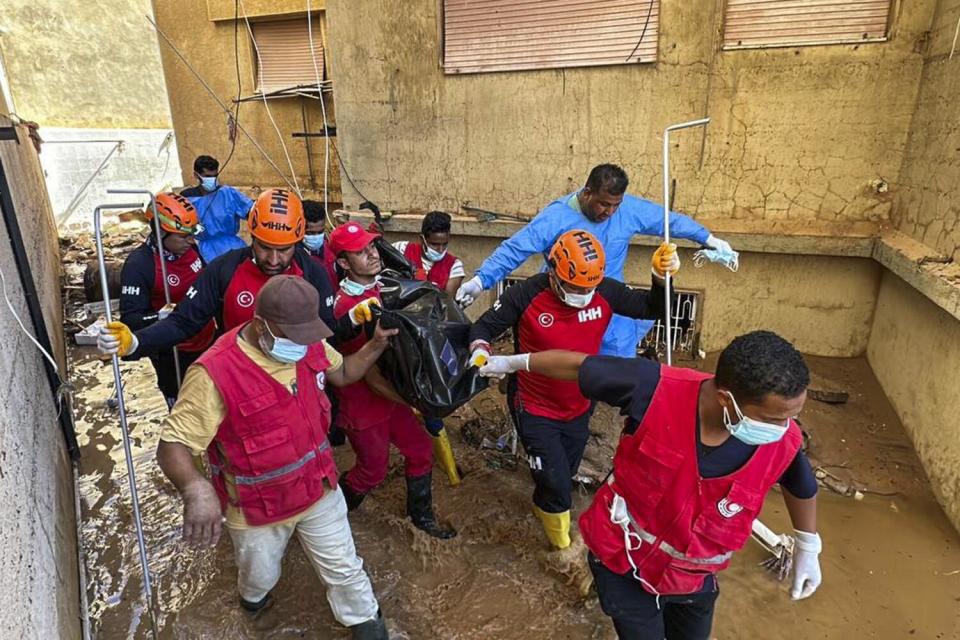After Libya flooding, retrieving the dead becomes as big a challenge as finding the living

The corpses are everywhere.
Buried under mud-filled husks of ruined homes. Wedged among smashed bridges and roadways. Drifting by the dozens — perhaps hundreds, even thousands — in the detritus-filled sea.
In the days after a powerful storm lashed Libya’s coastline and floodwaters from two burst dams swept part of the city of Derna into the sea, authorities have understandably focused on the living, racing to find and evacuate survivors. But they also must contend with the dead and collect and bury the growing number of victims before their bodies turn Derna into a massive contamination site.
“This is the fourth day after the flooding. The corpses will start to decompose,” Ahmed Zouiten, the World Health Organization’s representative in Libya, said Thursday. “This will be an environmental catastrophe.”

Officials with the Libyan Red Crescent group so far have put the death toll at more than 11,000, with thousands of bodies yet to be recovered. An estimated 10,000 people remain missing, with conflicting figures from different agencies. There are fears that the death toll could almost double as rescue efforts wind down and become more focused on recovery.
“The number is increasing. It could reach 18,000 to 20,000 people. This is what we expect,” Derna Mayor Abdulmenam Ghaithi said in an interview Wednesday with Saudi-owned Al Arabiya television.
Read more: What's delaying lifesaving aid after Morocco and Libya natural disasters? Politics
The catastrophe was triggered by Mediterranean Storm Daniel, which over the weekend dumped almost 16 inches of rain within 24 hours on Libya’s northeastern coast — a region that normally receives about 0.06 of an inch over the entire month of September. The deluge overwhelmed two dams upstream of Derna, which unleashed an estimated 1.05 billion cubic feet of water that crashed through Wadi Derna, the valley that bisects the city, wiping at least three neighborhoods off the map.
Rescue crews are trying to find anyone who might be trapped in the wreckage. But Ghaithi said his ravaged city, which had a population of 100,000, also needs “teams specialized in recovering bodies,” which litter both land and sea.
“I fear that the city will be infected with an epidemic due to the large number of bodies under the rubble and in the water,” he told the Reuters news agency.
The challenge of retrieving the corpses is gargantuan in a country riven by two competing governments — one in the east, the other in the west — and beset by infrastructure hollowed out by more than a decade of a previous war.
“We simply have no capabilities. Even masks and gloves, we don’t have enough,” Abdul Qader Saleh, a member of Derna’s commission for boy and girl scouts, said in a phone interview Thursday from the devastated city. “Yesterday we saw bodies and we can’t get to them. We need bulldozers, machines, even shovels.”
Several countries have dispatched rescue teams, including Egypt, Turkey, Jordan, Tunisia, Algeria, the United Arab Emirates and France. Germany, Finland and Romania have also sent assistance.
Read more: Whole families drowned within minutes in Libya's floods after dams burst
Teams of frogmen and units from the self-styled Libyan National Army — the armed group that acts as the military force of the Benghazi-based eastern administration — have worked to recover bodies from the Mediterranean near Derna. Many are thought to have been pulled away from shore by the current, said Ahmad Hadal, a Libyan journalist from Derna.
“As I’m talking to you now, I received reports they retrieved a body from Qardabah” — 65 miles southeast of Derna, he said.
With the hospitals in Derna all but knocked out, emergency crews had initially deposited all corpses at one clinic with the aim of storing them for families to retrieve and of issuing death certificates, said Mohamed Eljarh, an analyst who heads the Benghazi-based Libya Desk consulting firm.
sulting firm.

“Then they realized the bodies were decomposing, so now they’re just taking photos for identification and then putting them in mass graves,” he said.
“The bodies are still coming out. The smell of death is everywhere.”
Osama Ali, a spokesman for the Ambulance and Emergency Service of the western government based in Tripoli, which has offered assistance to the east, said the procession of death was ceaseless.
“In one site we removed 500 corpses altogether,” he said, explaining why authorities had to resort to mass graves.
Read more: Video: Thousands dead as floodwaters inundate Libya
But even those rudimentary burials have been affected by Libya’s lack of resources, with body bags in short supply, said Zouiten of the World Health Organization. He added that a WHO plane carrying 32 tons of medical supplies, including body bags, was en route to Libya from the organization’s hub in Dubai and would arrive Friday.
“It’s reached the point where we don’t even have enough kafans,” said Nagib Tarhoni, a doctor at the largest hospital near Derna, referring to the shrouds used by Muslims for burial.
“We couldn’t wash and wrap some of [the bodies] because they were too decomposed,” he said. “Others we couldn’t identify from the bloating, and of course many were mutilated in the floods.”
Because much of Derna is waterlogged, authorities designated burial sites in cemeteries outside the city. But those have filled to capacity, Tarhoni said, forcing authorities to find new areas.
For families desperate for news of their loved ones, the patchwork response among the various administrations and aid groups has left them with precious little information, analyst Eljarh said. Many have tried to enter the city to conduct their own searches, complicating humanitarian access already snarled by destroyed and obstructed roads.
“The crisis room in Derna was slow to tell people Derna is off-limits, to tell them that ‘we’re looking for your loved ones, and this is where we’ll we put the bodies,’” he said. “The No. 1 issue is very clear lack of organization and management for the scale of the disaster.”
So far, authorities say they have evacuated more than 30,000 people from Derna and imposed restrictions on who can enter so as to reduce traffic.
The terrible irony of the situation, Eljarh said, is that despite the deluge in Derna, there is no clean water available in the city. The floods knocked out the sewage system, leading to fears of tainted drinking water. And aside from corpses, authorities will have to also clear away the carcasses of animals to prevent contamination.
Read more: Displaced by last week's earthquake, Moroccan families brace for shelter-less nights
The greater question, Tarhoni said, is whether Derna can be made habitable again.
“People have lost jobs. They’ve lost homes. The city is facing a huge hygienic problem, water issues, supply issues, no hospitals. It’s just not a livable city anymore,” he said.
“The displacement will be on a huge scale.”
This story originally appeared in Los Angeles Times.

